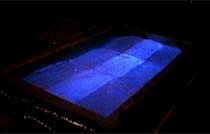Antarctica, California
When researchers at Stanford Linear Accelerator Center realized their distance from Antarctica was a scientific inconvenience, they set about crafting an icy world of their own in Menlo Park, California.
For two months beginning December 2006, the Antarctic Impulsive Transient Antenna (ANITA) array, a new NASA probe, will circle the South Pole aboard a high-altitude balloon, seeking signs of neutrinos hitting the ice below. But for researchers to make sense of ANITA's measurements, they needed to first calibrate the 20-foot-tall detector. They brought the detector to SLAC in June where the high-energy electron beam was ready to use. All they needed was ice.
 |
|
To view streaming video of the ANITA experiment, click on the image of the ice. (Requires Real Media Player) |
A truck rolled in through SLAC's gates, loaded with more than 10 tons of ice for a crew of workers to build a mini-Antarctica within a hangar-sized experimental hall. Overhead, the antenna array dangled from a gantry crane, ready to observe.
Collaborators then blasted the ice with a beam of electrons to create radio waves, perfectly tuned for calibrating the detector. When ultra-high-energy cosmic neutrinos strike the Antarctic ice sheet, they can also generate radio waves for ANITA to detect.
In addition to radio waves, the electron beam causes bright blue flashes of Cerenkov radiation, created whenever a charged particle moves faster than light through a dense medium, such as ice.
Just as those present saw the flashing blue light in a Californian ice sheet, a lucky observer on the Antarctic ice might occasionally see a similar Cerenkov flash, the sign of passing cosmic neutrinos.
Brad Plummer
Click here to download the pdf version of this article.






